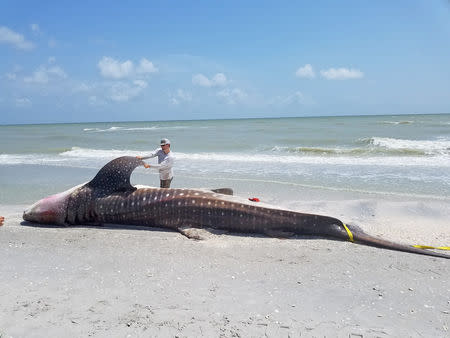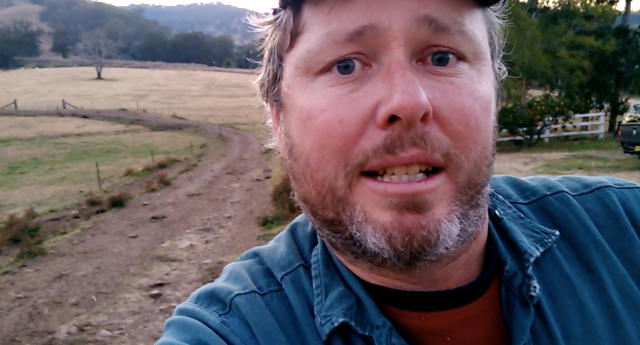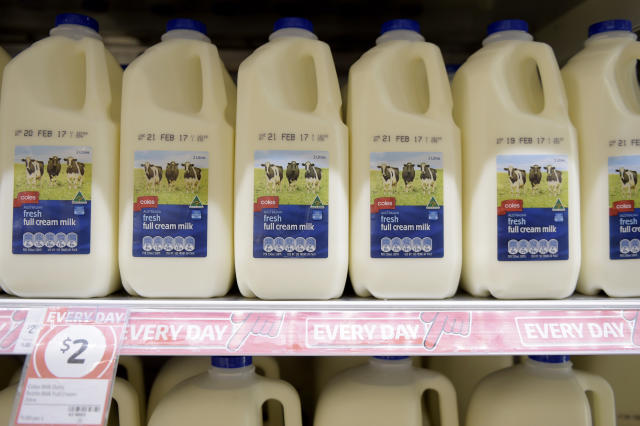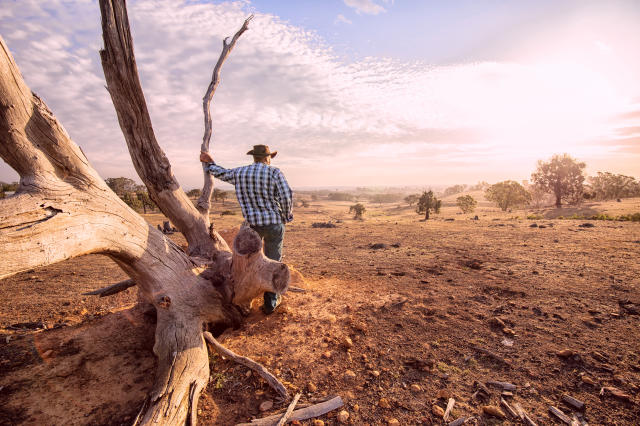Los Angeles Times
Steve Lopez: Ignore the climate change deniers. California’s hellish summer really is a grave warning
By Steve Lopez August 11, 2018
Felipe Montiel fishes at Lake Elsinore as the Holy fire reflects across the water while burning in the Cleveland National Forest above homes in Lake Elsinore. (Allen J. Schaben / Los Angeles Times)
Wind-swept wildfires raging. Homes incinerated. Families displaced. Lives lost.
In the long, hot, smoky California summer of 2018, as we camp under ash-hued sunset skies, the scariest thought is that the future has arrived, and more intense weather extremes will continue to wreak havoc in years to come. Not just in summer, but with drought-deluge cycles and higher temperatures even in cooler months.
Last week, an 81-year-old Van Nuys resident told me that sure, summers have always been hot, but lately they seem to have been imported from Palm Springs.
Near Santa Cruz, a winery owner told me there are fewer foggy days and more high temperatures, shrinking what have long been prime grape-growing regions.
But not everyone is alarmed, it turns out, which I’ve discovered since my July 18 column on climate change. Reaction has fallen into the following categories:
There is no climate change, and I’m a stooge to have fallen for a hoax.
Global warming exists, but it’s not man-made.
Climate change is real, but it’s silly to believe California’s environmental zealotry can measurably improve a global problem.
And lastly, if climate change is real and it’s here, what can we do about it legislatively and individually?
So let’s take a look at each one, beginning with those who believe — as does the president of the United States and a number of his key advisors and members of Congress — that climate change is a figment of our imaginations, or that we’re overreacting to what might simply be natural variations.
“You see, Steve, what you call global warming, we call summer,” wrote a reader named Jim.
“They say the temps are the highest recorded in 130 years,” wrote Joe. “What was the excuse for the soaring temps 130 years ago when there were no cars and very, very little industrialization … here’s a clue — it’s a HOAX swallowed whole by the rush of lemmings who want to believe they are doing gooooooooooood things for the planet.”
I responded by telling Joe what several climate scientists have painstakingly explained to me in recent weeks:
Yes, unusually high temperatures have always existed, but scientists have now documented more frequent and intense heat waves of longer duration. Also, nighttime temperatures have increased, record highs now outnumber record lows by a 5-1 ratio and atmospheric carbon dioxide has increased from 250 parts per million to 400 parts per million, all of which has altered climates around the world.
Joe called this information “crap” that can’t stand up to “REAL SCIENTIFIC SCRUTINY.” He suggested I look up the writings of climate scientist Judith Curry, who has long attacked the views of many climate scientists as alarmist. Curry has not challenged the notion of global warming, but has questioned the causes, and whether there has been a rush to judgment.
Ben Santer, a climate scientist with the Lawrence Livermore National Laboratory, had this to say:
“Prof. Curry has argued (and continues to argue) that: 1) climate scientists routinely ignore important uncertainties in their efforts to quantify human influences on global climate; and 2) reality is too complex for us to comprehend; we will never understand the real-world climate system.”
Santer said he disagrees with Curry on both counts.
“In my line of research — climate fingerprinting — we routinely consider uncertainties in satellite temperature data, in model simulations of natural variability, and in model estimates of the climate response to human influences,” Santer said.
“Furthermore, we routinely look at other possible explanations for the observed changes in climate (such as changes in the Sun’s energy output and changes in volcanic activity). Uncertainty is an integral part of our work. We do not sweep it under the carpet, as Prof. Curry incorrectly asserts,” Santer said.
He added that despite imperfect observations, it is clear “beyond any reasonable doubt” that evidence points to a “human-caused warming signal” related to greenhouse gas increases. And if we wait for more perfect data before responding, Santer warned, “humanity is in trouble.”
California isn’t waiting. The state has long led the way on embracing renewable energysources and limiting greenhouse gas emissions. Then there’s the current legislation demanding better gas mileage in the near future, which is under attack by the Trump administration. But as a single state in a world of major polluters, can going green make a difference?
Alex Hall, a UCLA climate scientist, has no doubt.
“I think what’s happening in California is wonderful,” said Hall, who traded his gas-hungry car for a Chevy Bolt. “It’s a pathway forward.”
Environmentalism isn’t sacrifice, Hall said. It’s change. And in charting a course toward renewable energy and lower greenhouse gas emissions, California is setting an agenda.
“If you look at any transformation in history, it hasn’t happened all at once everywhere,” Hall said. “It’s been a small group of people committed to change. They’ve made change in their communities and it scaled up from there.”
Lynn Sosa of Mt. Washington emailed to say she wishes outdoor mall merchants would close their doors in the middle of summer, instead of throwing them open so shoppers might be lured in by air-conditioned blasts. Sosa and her husband, Jeffrey Parkin, suggested I visit Glendale’s Americana on Brand, and sure enough, more than half the shops had their doors open as the temperature hit 98 one afternoon.
The Apple store was one of them, and Tesla was another — a Tesla showroom with electric cars on display, along with a wall-mounted solar pitch: “Energy Security for Your Home.”
Maybe Tesla/Space X engineering guru Elon Musk has a plan to reverse global warming with air conditioning?
Actually, said the Tesla sales clerk, the AC was working so hard with the doors wide open, it had been on the fritz two or three times in recent weeks. He said that keeping the doors open was mall policy, but Americana owner Rick Caruso denied that and called it unacceptable, promising to look into it.
“We are adamant that we are environmentally sensitive,” Caruso said.
“Adaptation is survival, and we have to do it in our personal and professional lives,” said David Fink, a climate change policy consultant whose projects include updating the state’s Cal-Adapt.org website, which logs climate change data to aid in planning decisions.
We have to be smarter about how we get places, how much fuel we burn, where we clear brush and where we plant trees, where we allow new housing developments and what materials we use to build them, Fink said.
“Laying down black asphalt everywhere is one of the worst things we can be doing,” said Fink, who told me about light-colored coating materials that don’t retain as much heat.
The same concept is true, he added, for new roofing materials that reflect rather than absorb heat.
“A key to all of this is that a number of these things are either free or there are incentives or rebates available,” said Fink, who recommended going to LADWP.com and clicking on “rebates” for information.
There are, of course, ways to make an impact on a bigger scale, or to at least try. You can speak up for candidates who understand the threat to the planet, or you can scream about destructive environmental policy bought and paid for by fossil fuel barons.
As Santer said, one of the best things you can do is educate yourself. He suggested that I read “Climate Change Evidence & Causes,” a short summary that’s been neatly laid out by the Royal Society and the U.S. National Academy of Sciences.
I grew up in California, lived in the Bay Area for 30 years and in Southern California for 20 more, and yes, climate variations have always existed. I can recall many extremes of dry heat and steady rain.
But this looks and feels different. The hills are drier and more combustible, the heat is hotter and more stubborn, the fires are bigger and more frightening and I can only wonder what we’ll be passing on to my daughter and future generations.
However many naysayers there are, including a president who blames California’s catastrophe on everything but global warming, leading the way on educating, planning and adapting isn’t just possible, it’s a moral imperative.
Steve Lopez is a California native who has been an L.A. Times columnist since 2001. He has won more than a dozen national journalism awards for his reporting and column writing at seven newspapers and four news magazines, and is a three-time Pulitzer finalist for commentary – in 2012, for his columns on elder care; in 2016, for his columns on income inequality in California; and in 2018, for his columns on housing and homelessness. He is the author of three novels, two collections of columns and a non-fiction work called “The Soloist,” which was a Los Angeles Times and New York Times best-seller, winner of the PEN USA Literary Award for Non-Fiction, and the subject of a Dream Works movie by the same name. Lopez’s television reporting for public station KCET has won three local news Emmys, three Golden Mike awards and a share of the Columbia University DuPont Award.
Related:
L.A. Times
Climate change deniers aren’t worth any news coverage
To the editor: Steve Lopez writes effectively about climate change. But I have a question: Why does he feel he must give any ink, screen space or time to the deniers? These people make no valid arguments; there is no need to counter them. It’s time just to stop covering them.
It’s clear the deniers have scientists over a barrel. Of course no ethical scientist will be able to say, “This particular event is a result of climate change.” They have to talk about trends over time. That’s not a powerful way to counter the deniers. But why feel any need, anymore, to counter them? It’s all too clear, and there’s close to unanimous agreement among the ethical scientists. Countering the deniers makes their arguments seem legitimate.
I agree that leading the way on educating, planning and adapting is a moral imperative. But I’m sad that Lopez doesn’t include the word “preventing.” Obviously we are already in it, and we can’t prevent some of the effects of climate change. But are we really ready to stop talking about preventing the worst effects? I say no.
Mary Byrd, Santa Barbara
To the editor: The climate change debate reminds me of my youth, when I did some technical rock climbing.
The decision to use a safety rope was not based on the likelihood of a fall, but instead on the consequences of a fall. If a fall would be a disaster, we would rope up, even though it was inconvenient and a fall was unlikely. It seems the same logic applies to climate change.
Even if there was a lack of scientific consensus, the consequences of failing to respond to climate change would still demand action. Reducing carbon dioxide emissions will also reduce other forms of pollution, leading to a large decrease in preventable premature deaths.
If our civilization lasts long enough, we will run out of economically viable fossil fuels. It may be decades or it may be centuries, but the earlier we transition to a low-carbon lifestyle, the greater the benefit to mankind.
Tom Hazelleaf, Seal Beach
To the editor: Isn’t it time we stop arguing about what is causing climate change and start figuring out ways to adapt? It’s here. It’s real.
Switching to cleaner, greener energy may slow the exponential speed with which this planet is warming, but it will not stop or reverse it. The time is now (if it’s not already too late) to figure out how to live in this new reality.
Do we just wait around for the next inevitable disaster and shake our heads and shrug our shoulders and say “this is the way it is”? Do we continue to argue about what is causing this? Or do we try to adapt and learn how to survive and live with this new reality?
Roselee Packham, Santa Monica
To the editor: Lopez is correct when he agrees there is indeed global warming. However, he is wrong to concentrate only on summer temperatures. In Southern California, the winters are also getting warmer.
“Winter chill” is the number of hours temperatures reach 45 degrees or lower. In my community adjacent to Agoura Hills and Thousand Oaks, we had 544 hours of winter chill in 2000-01; last winter, we had only 191 hours. Only the winter of 2013-14 was warmer, with 127 hours of chill.
This means my peach tree — a variety specially developed for the mild winters of southern California — produces only two peaches this year instead of a tree full. More important, commercial orchards of peaches, almonds and cherries are struggling because of a lack of winter chill.
Warm winters can be as damaging to food crops as torrid summers.
David E. Ross, Oak Park

 © Greg Nash
© Greg Nash THE MONTEREY SHALE FORMATION IN CALIFORNIA, WHERE FRACKING IS USED TO EXTRACT GAS AND OIL DURING ONE OF THE WORST DROUGHTS IN STATE HISTORY, MARCH 2014. CREDIT: DAVID MCNEW/GETTY IMAGES
THE MONTEREY SHALE FORMATION IN CALIFORNIA, WHERE FRACKING IS USED TO EXTRACT GAS AND OIL DURING ONE OF THE WORST DROUGHTS IN STATE HISTORY, MARCH 2014. CREDIT: DAVID MCNEW/GETTY IMAGES
 SOME OF THE BIGGEST FRACKING SITES — LIKE THE PERMIAN AND EAGLE FORD BASINS — ARE IN HIGHLY WATER STRESSED AREAS. CREDIT: DUKE UNIVERSITY.
SOME OF THE BIGGEST FRACKING SITES — LIKE THE PERMIAN AND EAGLE FORD BASINS — ARE IN HIGHLY WATER STRESSED AREAS. CREDIT: DUKE UNIVERSITY.










 Farmer Shane Hickey took to Facebook to reveal the dire situation he and other farmers find themselves in. Source: Facebook/ Shane Hickey
Farmer Shane Hickey took to Facebook to reveal the dire situation he and other farmers find themselves in. Source: Facebook/ Shane Hickey Despite supermarkets retailing milk as cheap as $1 per liter, the ACCC report revealed they weren’t to blame for farmers struggling to make money. Source: Getty
Despite supermarkets retailing milk as cheap as $1 per liter, the ACCC report revealed they weren’t to blame for farmers struggling to make money. Source: Getty The drought affecting 100 per cent of NSW and substantial parts of Queensland is one of the worst to hit Australia in the last 100 years. Source: Getty
The drought affecting 100 per cent of NSW and substantial parts of Queensland is one of the worst to hit Australia in the last 100 years. Source: Getty
